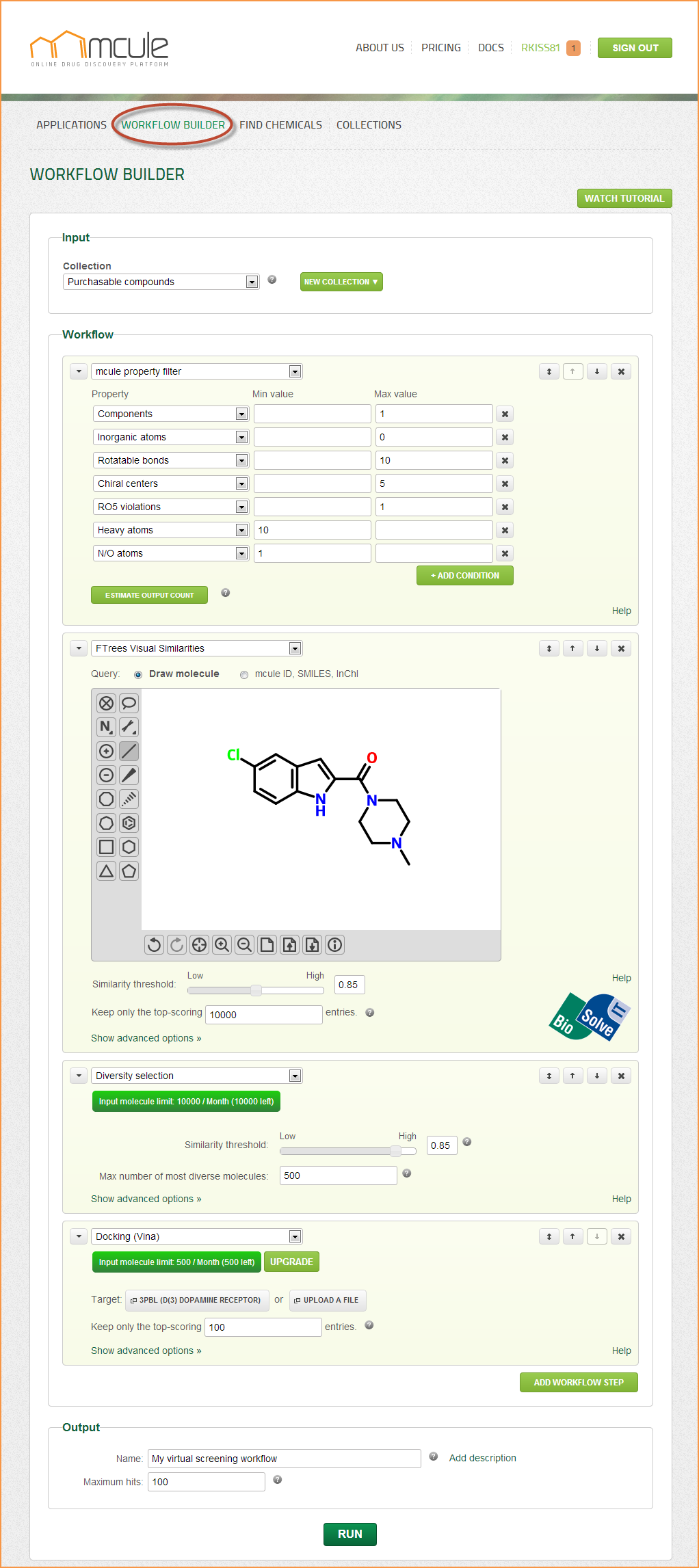This is an old revision of the document!
Workflow Builder
The Workflow Builder provides a comprehensive set of drug discovery tools that can be used as LEGO bricks to build up complex workflows. The built workflows can be effectively used for virtual screening and for screening library design.
The mcule technology revolutionizes compound selection by providing powerful, advanced searching and filtering tools in the Workflow Builder. You can design screening libraries by filtering the purchasable chemical space based on chemical diversity (large-scale diversity selection), product properties (e.g. purity, available stock amount, delivery time, etc.). Additionally, you can eliminate unwanted structures (SMARTS rules, physicochemical property filter) to focus on the highest quality compounds only. The mcule database can be searched, screened and filtered by using different drug discovery tools. These range from simple filters (e.g. mcule property filter) to more complex tools (e.g. Docking (Vina)). There are different interfaces for simple searches (“find chemicals” tab) and for more complex virtual screens (“workflow builder” tab).
Under the “workflow builder” tab, linear virtual screening workflows can be built. These workflows comprise of a chain of workflow steps. The workflow steps can be filters (e.g. mcule property filter) that reduce or generators that increase the number of entries in a collection. To check the list of the currently available workflow steps, click here.
You can add a name for each workflow (“Name” field at the top). This name will be associated to the screening workflow as well as to the collection containing the results of the screening workflow. If you leave this field blank, a unique, timestamped name will be generated automatically (e.g. search_2012-10-01_23:02:47.263886). If you would like to add a description for this workflow/collection, click on the “Add description” link to the right of the “Name” input field.
You can select on which collection the screen will be performed in the “Input collection” field. By default, the “Purchasable compounds collection” is set as input collection. Other collections (e.g. public collections or your previously created collections) can be also selected.
The “Maximum hits” field is set to 1,000 by default. If you don't want to limit the number of results, you can delete the number from this field. Note that if you are using the Free package, the maximum number of molecules in a single collection is 10,000, which implicitly limits the “Maximum hits” to 10,000.
By default only one workflow step is displayed. You can add more steps by clicking on the “Add workflow step” button, which can always be found under the last added workflow step on the right. The maximum number of workflow steps you can add into a single workflow is 10. The order of the workflow steps is arbitrary, i.e. any step can be put after any other step. However, when building a screening workflow it makes sense to consider at least two aspects: (i) speed and (ii) usage limits of the steps. For example, the mcule property filter is a workflow step with no monthly limits and it can reduce the size of the input collection very quickly, while Docking (Vina) is more computationally intensive and your allowance of the number of input molecules is limited. We therefore suggest that you put the mcule property filter first and add the Docking (Vina) step after. Here are some of the available workflow steps ordered by their speed:
Sampler > Exact search > Similarity search > Bulk exact search > Property filters > Substructure search > SMARTS query filter > REOS filter > ChemAxon calculators > FTrees Visual Similarities > Diversity selection > Docking (Vina)
To move the workflow steps upwards or downwards in a workflow, you can click on the up or down arrows in the upper right corner of each step’s box. If you would like to delete a workflow step, click on the “X” button in the upper right corner of the step box. To display/hide the details of a particular step, click on the disclosure triangle in the upper left corner of the step box.
All user-built workflows including the query molecules are saved and can be accessed together with the results by the user at any time. To do this, select the result collection (under the “Collections” tab) and click on “Display query”. Note that your queries and workflows will always be private, even if you change the privacy level of the result collection (they can never be seen by other users).
